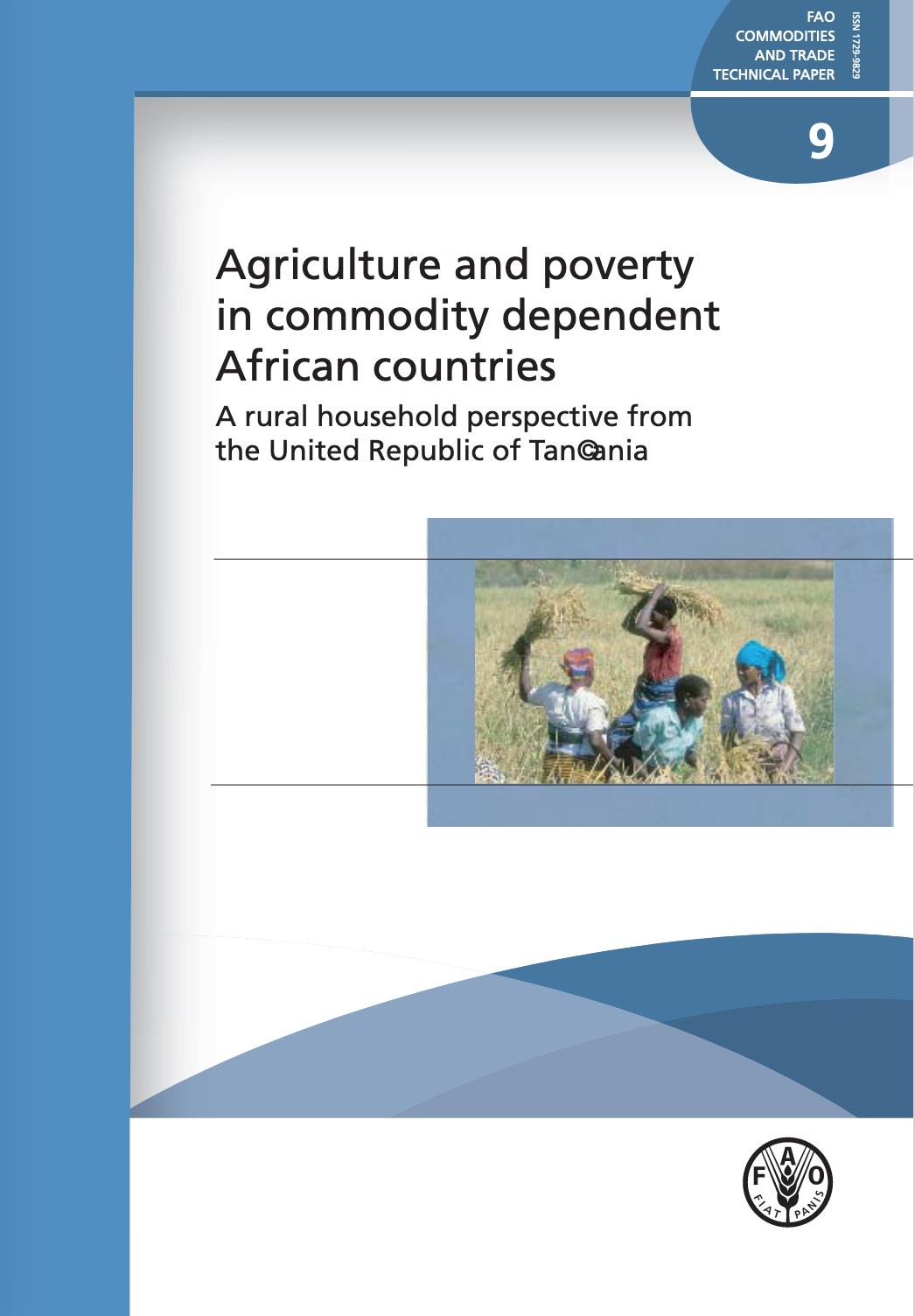
Agriculture and poverty in commodity dependent African countries - A rural household perspective from the United Republic of Tanzania
01/01/2007
This report explores how farm productivity affects poverty, and how various factor market constraints affect farm productivity. The empirical analysis draws on representative surveys of farm households in Kilimanjaro and Ruvuma, two cash crop growing regions in the United Republic of Tanzania. Poorer households were found not only to possess fewer assets, but also to be much less productive. Findings show that agricultural productivity directly affects household consumption and hence overall pov erty and welfare. Stochastic production frontier analysis indicates that many farmers are farming well below best practice in the region. Holding inputs constant, they attain on average only 60 percent of the output obtained by their best counterparts. Analysis of allocative efficiency suggests that family labour is substantially overutilized, a sign of considerable excess labour supply. Use of intermediate inputs on the other hand is well below what is commensurate with the estimated value of t heir marginal productivities. An important reason for low input use is lack of credit to purchase inputs, but difficult access to the inputs themselves and being connected to the economy more broadly are also important impediments. Easy access to credit is positively associated with being a member of a savings association or being in a contractual arrangement with a cooperative or firm. Irrigation infrastructure facilitates access to credit. Together these findings support a continuing emphasis on increasing agricultural productivity in designing poverty reduction policies. Better agronomic practices and increased input use will be crucial in this strategy. Better access to inputs and improved roads and transport services will further help boost input application. Financial constraints might be relieved through fostering institutional arrangements facilitating contract enforcement (e.g. contract farming, marketing cooperatives) and institutions that facilitate saving by the households themselves. They may also be relieved by the provision of more adequate consumption safety nets. The overall results suggest that a pro-poor rural development strategy needs to be anchored around improvements in agricultural productivity.
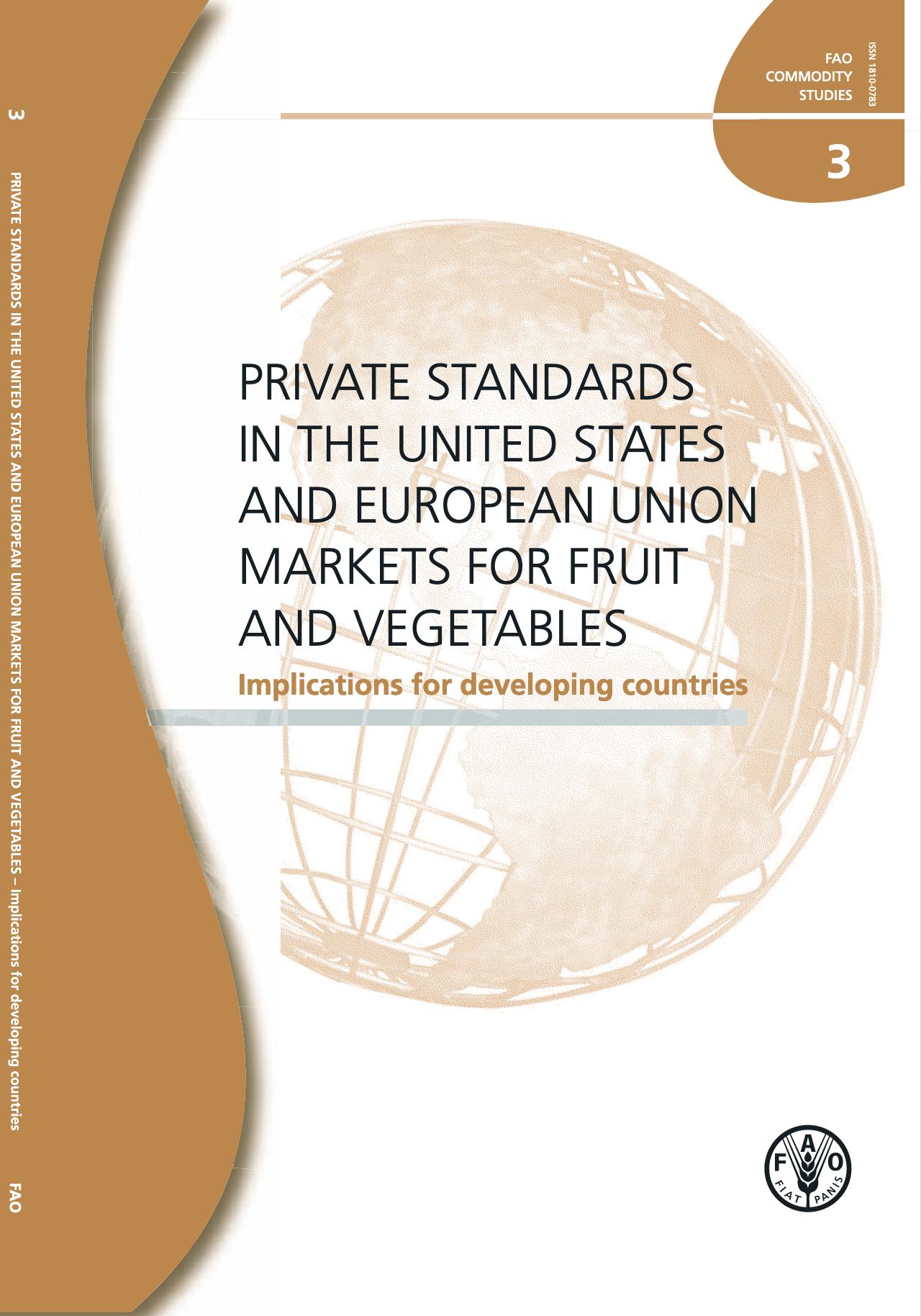
Private Standards In The United States And European Union Markets For Fruit And Vegetables
01/01/2007
Over the past 20 years the number of standards and certification programmes for agricultural production has grown rapidly. Producers who want to export are confronted not only by a plethora of import regulations, but also within import countries by different niche markets for which specific requirements have to be fulfilled. While the adoption of voluntary standards may grant export opportunities to farmers, they can also be considered barriers to entry for those who cannot apply them either because they are too onerous or because of the lack of knowledge about their requirements. In fact, some producers and exporters increasingly regard private standards as non‑tariff barriers to trade. New and more stringent standards are being developed year after year, and there is an urgent need to determine today, and in the future, the extent to which these govern world trade. This report gives an overview of standards and certification programmes relevant for fruit and v egetable producers and exporters in developing countries with a focus on the markets of the United States and the European Union. In addition, it gives an overview of current analytical work on standards and trade, reviews major assistance programmes related to standards and provides recommendations for further research.
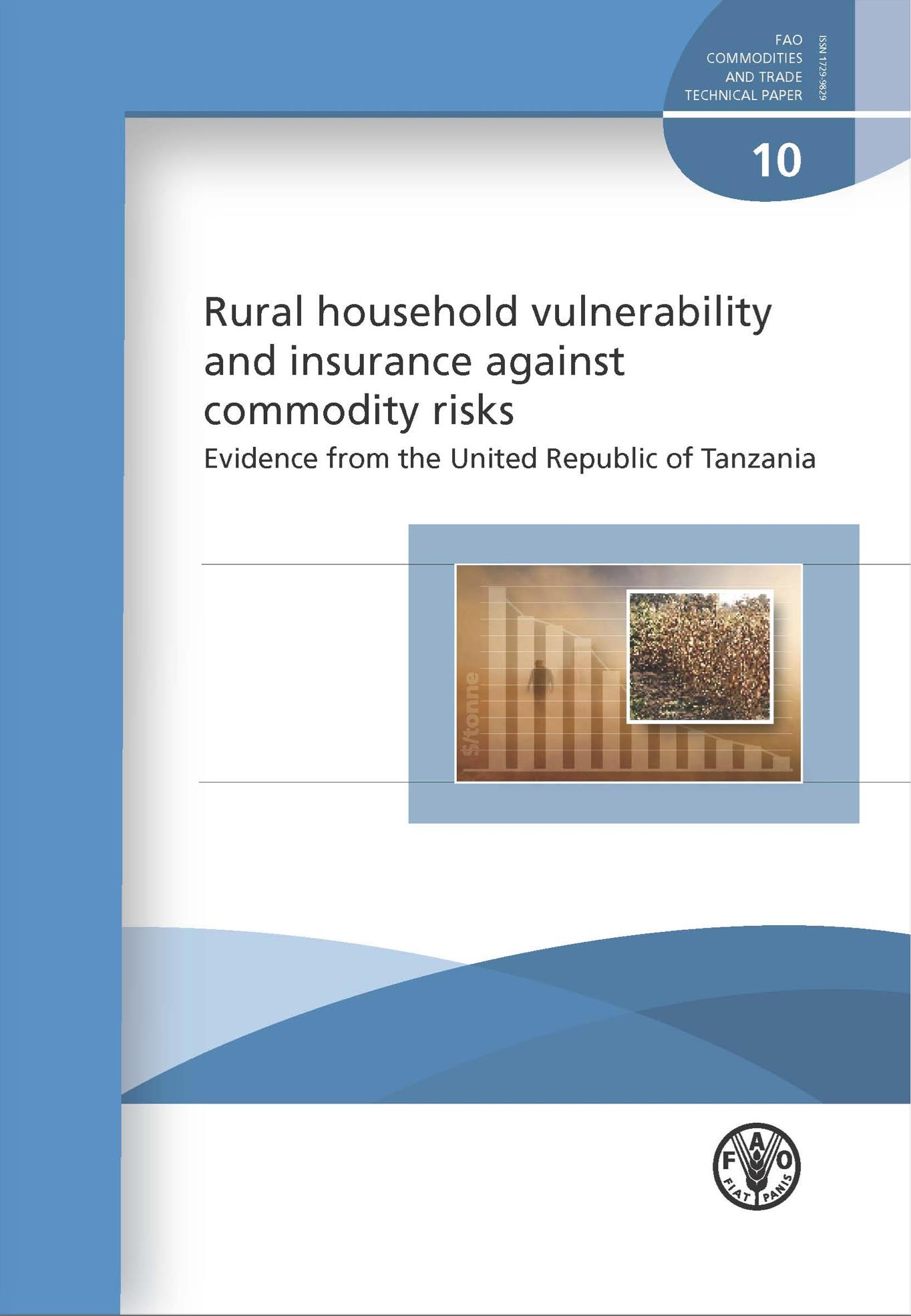
Rural household vulnerability and insurance against commodity risks - Evidence from the United Republic of Tanzania
01/01/2007
This report has two objectives. It assesses the nature and the extent of vulnerability among rural households in Tanzania with a particular focus on smallholder cash crop growers through exploring all risks, including the decline in commodity prices. It further explores the potential role for market based insurance schemes such as commodity price and weather based insurance to mitigate household vulnerability. The empirical analysis is based on two rounds of specifically designed r epresentative surveys of farm households in Kilimanjaro and Ruvuma, two cash crop growing regions in the United Republic of Tanzania in 2003 and 2004. The contrasting experiences of a richer (Kilimanjaro) and a poorer (Ruvuma) region substantially enriches the policy guidance emerging from the report. The report applies descriptive, econometric and contingent valuation techniques to achieve its objectives. The findings identify drought, health and commodity price shocks as the key risks faced by rural households in Kilimanjaro and Ruvuma. The welfare losses associated with these shocks are substantial. Households extensively use self and mutual insurance to cope with these shocks, but nonetheless, there remains substantial uninsured risks as indicated by the considerable stated demand for coffee and weather based insurance which could have important societal benefits. The latent demand for insurance further suggests that current ways of coping may not be eff icient and that there may be important economic opportunities which insurance could open up. Liquidity constraints emerge as important impediments in adopting such market based insurance schemes. Great care will need to go into the design and institutional delivery mechanisms of market based insurance. The establishment of interlinked markets such as input, credit and insurance packages deserves special attention in this regard. Finally, other, more traditional, public intervention s such as providing public health services, fostering connectivity and access to off-farm employment, and better water management techniques were also identified as promising household vulnerability reducing interventions.
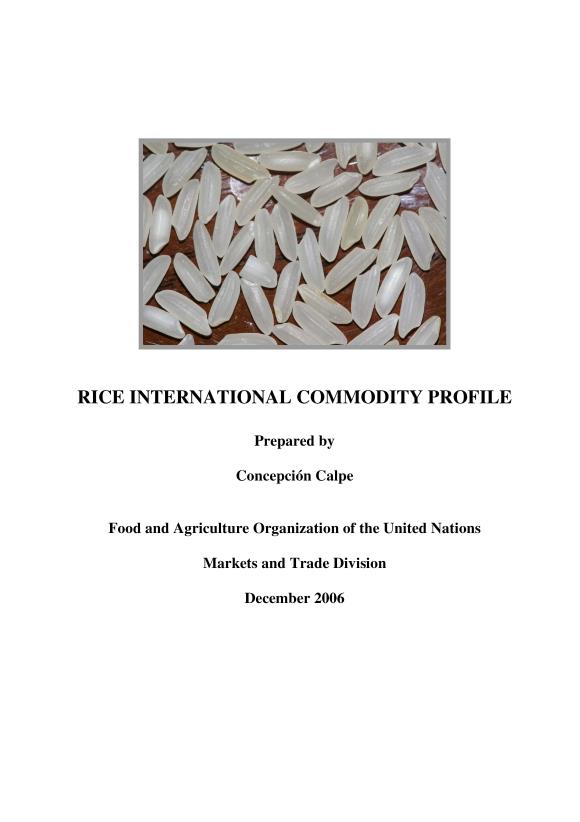
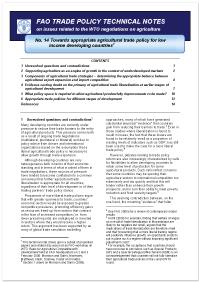
No. 14 Towards appropriate agricultural trade policy for low income developing countries
12/12/2006
Many developing countries are currently under pressure to reduce their trade barriers to the entry of agricultural products. This pressure comes both as a result of ongoing trade negotiations (multilateral, plurilateral or bilateral) and due to policy advice from donors and international organizations based on the assumption that a liberal agricultural trade policy is necessary to allow growth through trade expansion. Although developing countries are very heterogeneous both in terms of their economic standing and in terms of what is asked of them in trade negotiations, these sources of pressure have tended to become conflated into a common consensus that further agricultural trade liberalization is appropriate for all countries, regardless of their level of development or of their trading partners trade policy stance.
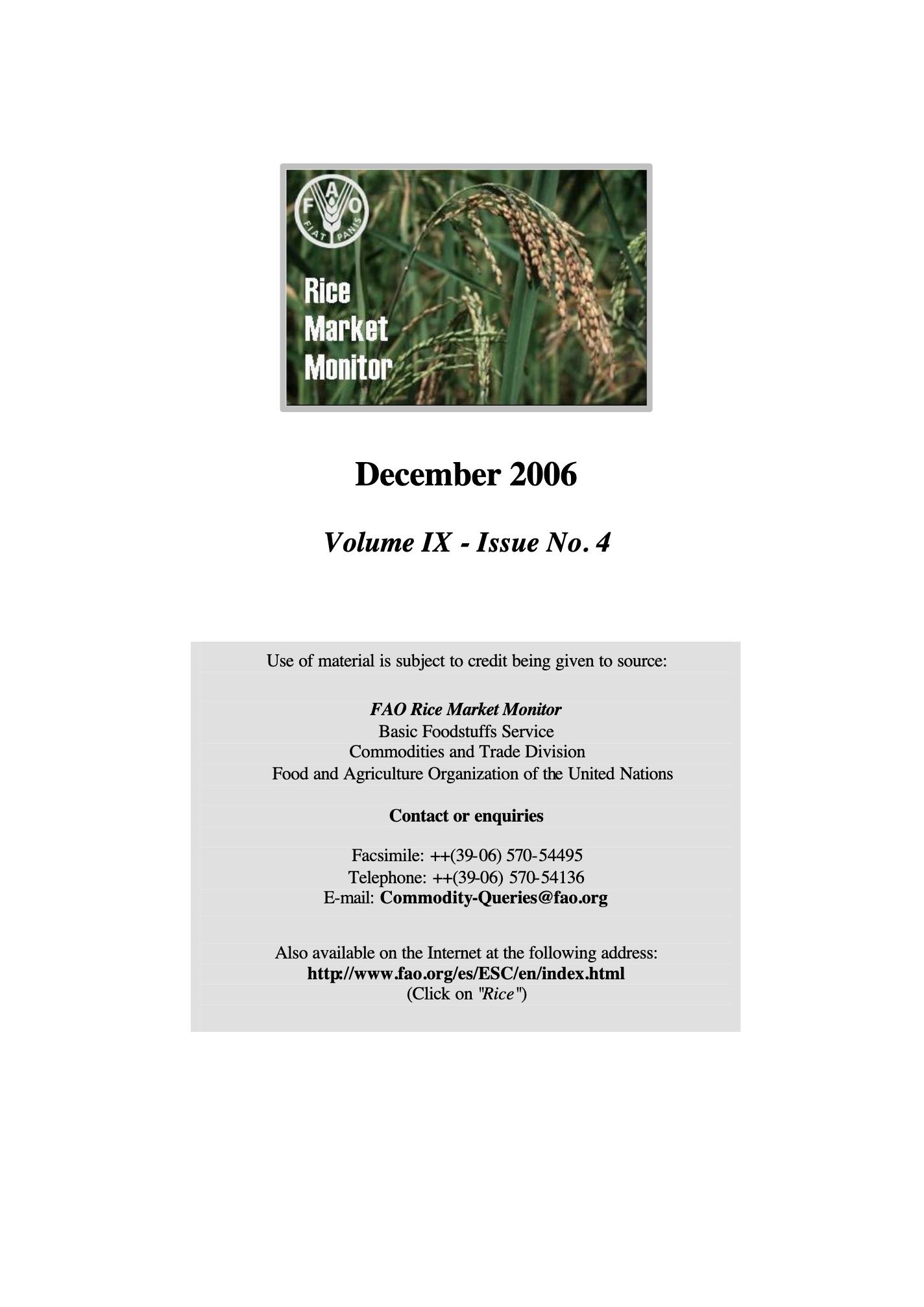
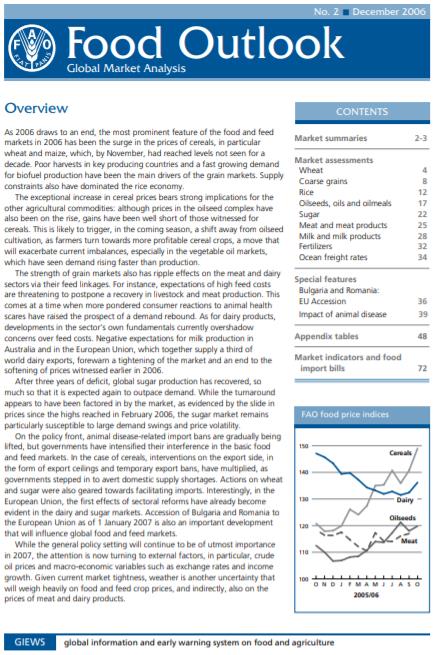
Food Outlook - December 2006
04/12/2006
As 2006 draws to an end, the most prominent feature of the food and feed markets in 2006 has been the surge in the prices of cereals, in particular wheat and maize, which, by November, had reached levels not seen for a decade. Poor harvests in key producing countries and a fast growing demand for biofuel production have been the main drivers of the grain markets. Supply constraints also have dominated the rice economy.
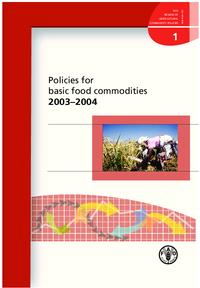
Policies for basic food commodities 2003-2004
01/12/2006
This third staple food policy review indicates the main policy changes that took place in 2003 and 2004 in the areas of production, consumption, marketing and trade of grains, oilseeds and oil. breeding. The data come from questionnaires and from official and unofficial sources.
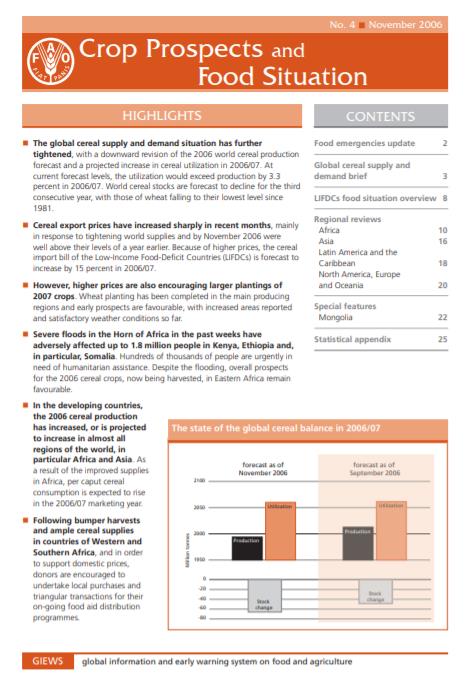
Crop Prospects and Food Situation #4, November 2006
09/11/2006
The global cereal supply and demand situation has further tightened, with a downward revision of the 2006 world cereal production forecast and a projected increase in cereal utilization in 2006/07. At current forecast levels, the utilization would exceed production by 3.3 percent in 2006/07. World cereal stocks are forecast to decline for the third consecutive year, with those of wheat falling to their lowest level since 1981. Cereal export prices have increased sharply in recent months, mainly in response to tightening world supplies and by November 2006 were well above their levels of a year earlier. Because of higher prices, the cereal import bill of the Low-Income Food-Deficit Countries (LIFDCs) is forecast to increase by 15 percent in 2006/07.
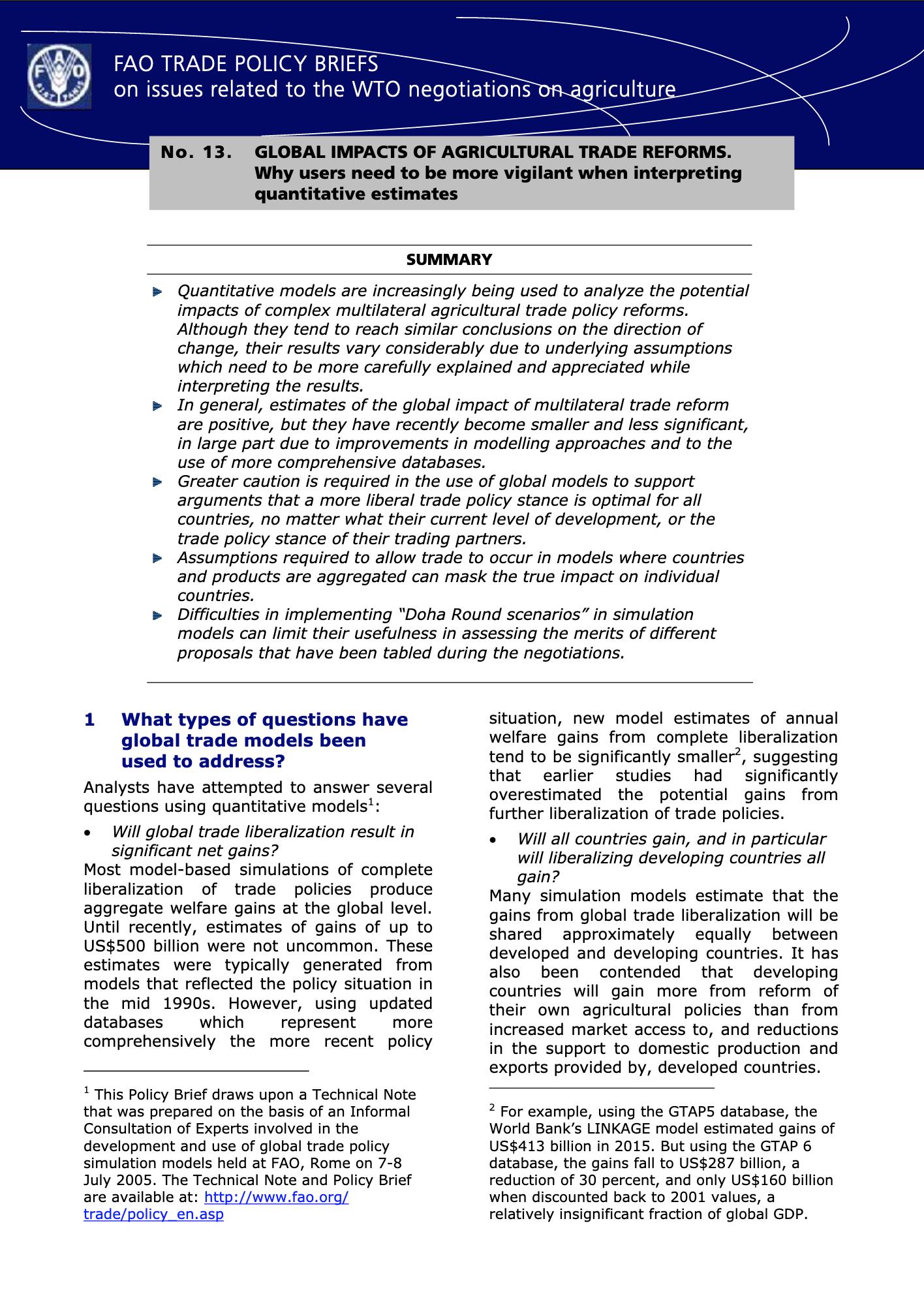
No. 13 Trade policy simulation models: Estimating global impacts of agricultural trade policy reform in the Doha Round
07/11/2006
There has been a recent proliferation of simulation modelling exercises attempting to quantify the potential economic gains from further liberalization of agricultural trade, and in doing so, seeking to inform the current Doha Round of multilateral trade negotiations. This paper seeks to contribute to a better appreciation of what the results of simulation models actually mean, and the extent to which they can be used to inform debates relating to trade policy reform.
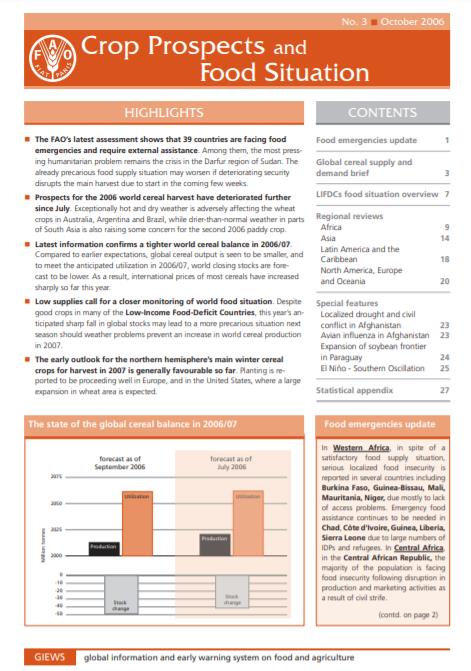
Crop Prospects and Food Situation #3, October 2006
05/10/2006
The FAO’s latest assessment shows that 39 countries are facing food emergencies and require external assistance. Among them, the most pressing humanitarian problem remains the crisis in the Darfur region of Sudan. The already precarious food supply situation may worsen if deteriorating security disrupts the main harvest due to start in the coming few weeks. Prospects for the 2006 world cereal harvest have deteriorated further since July. Exceptionally hot and dry weather is adversely affecting the wheat crops in Australia, Argentina and Brazil, while drier-than-normal weather in parts of South Asia is also raising some concern for the second 2006 paddy crop. Latest information confirms a tighter world cereal balance in 2006/07. Compared to earlier expectations, global cereal output is seen to be smaller, and to meet the anticipated utilization in 2006/07, world closing stocks are forecast to be lower. As a result, international prices of most cereals have increased sharply so far this year. Low supplies call for a closer monitoring of world food situation. Despite good crops in many of the Low-Income Food-Deficit Countries, this year’s anticipated sharp fall in global stocks may lead to a more precarious situation next season should weather problems prevent an increase in world cereal production in 2007. The early outlook for the northern hemisphere’s main winter cereal crops for harvest in 2007 is generally favourable so far. Planting is reported to be proceeding well in Europe, and in the United States, where a large expansion in wheat area is expected.
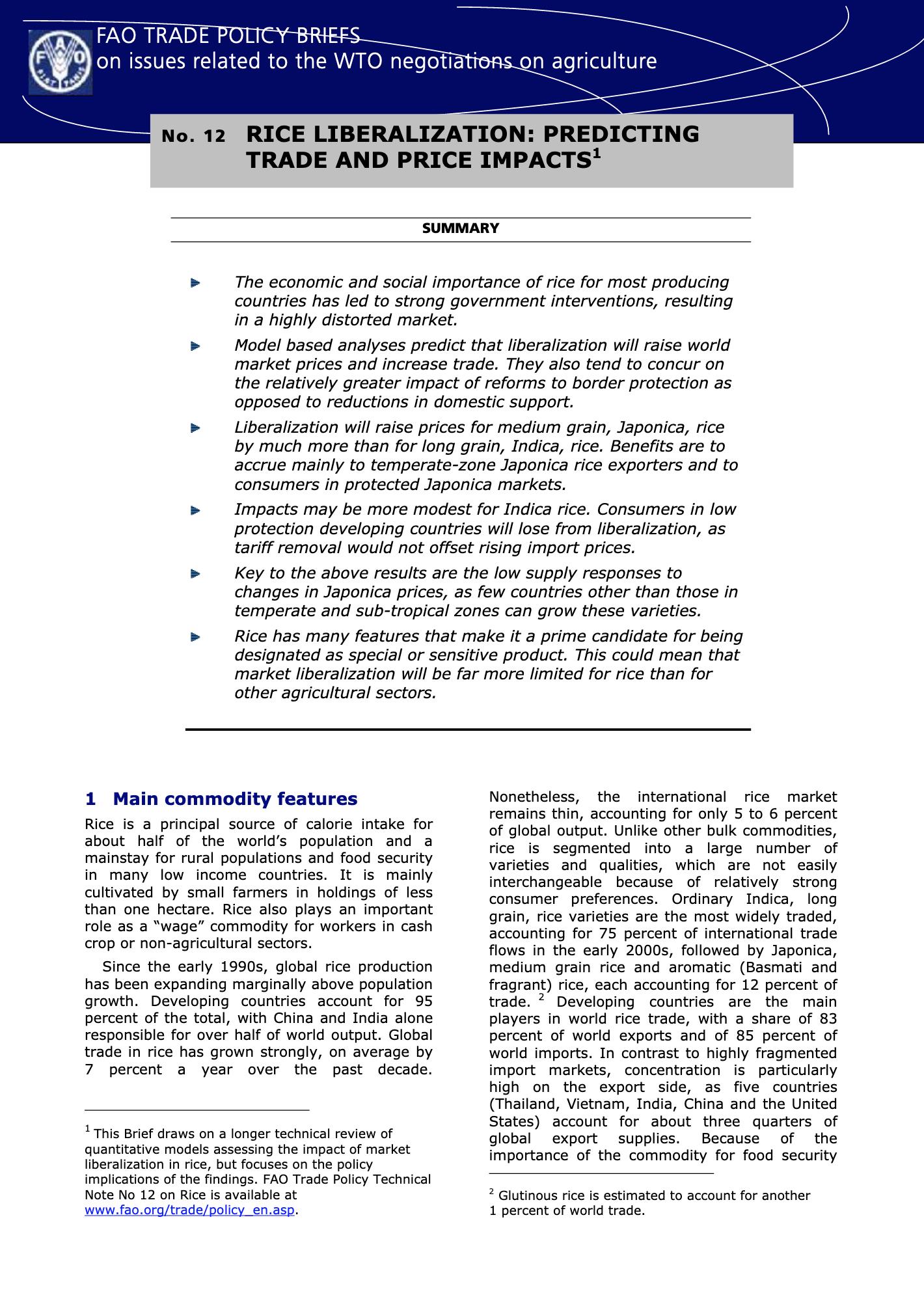
No. 12. Rice: what do analytical model results tell us? - October 2006
03/10/2006
2004 was declared the International Year of Rice by the United Nations General Assembly, a tribute to a commodity that is the staple food for about half of the world’s population and also a major income earner in developing countries. Because of its strategic importance, rice has been subject to a host of policy interventions that have made it feature among the most distorted of all agricultural commodities. For this reason, rice is frequently specified in models that analyse the effects of trad e liberalization. The objective of this technical note is to review and compare the various analytical tools employed to assess such impacts, with the ultimate aim of shedding some light on critical issues under discussion in the current WTO Multilateral Trade Negotiations.
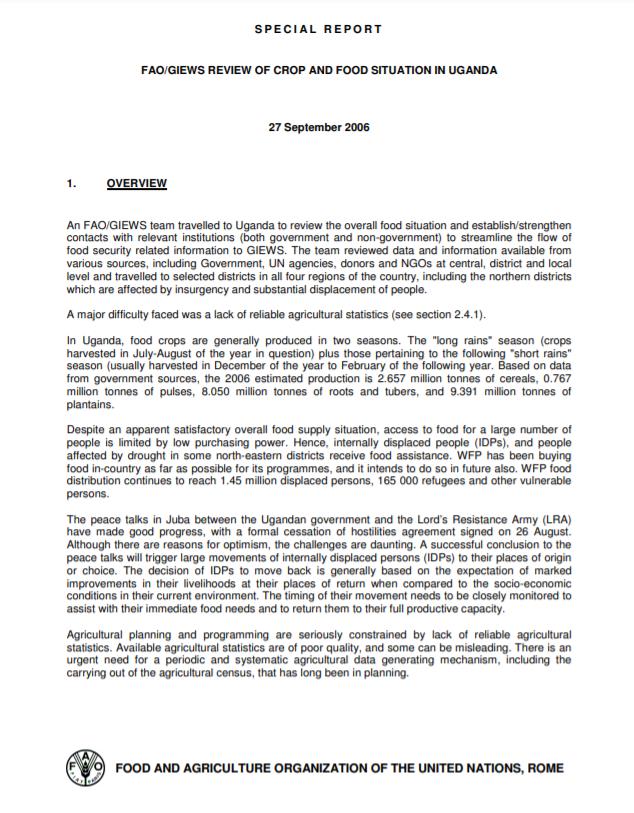
Special Report - FAO/GIEWS Review of Crop and Food Situation in Uganga
27/09/2006
An FAO/GIEWS team travelled to Uganda to review the overall food situation and establish/strengthen contacts with relevant institutions (both government and non-government) to streamline the flow of food security related information to GIEWS. The team reviewed data and information available from various sources, including Government, UN agencies, donors and NGOs at central, district and local level and travelled to selected districts in all four regions of the country, including the northern districts which are affected by insurgency and substantial displacement of people.
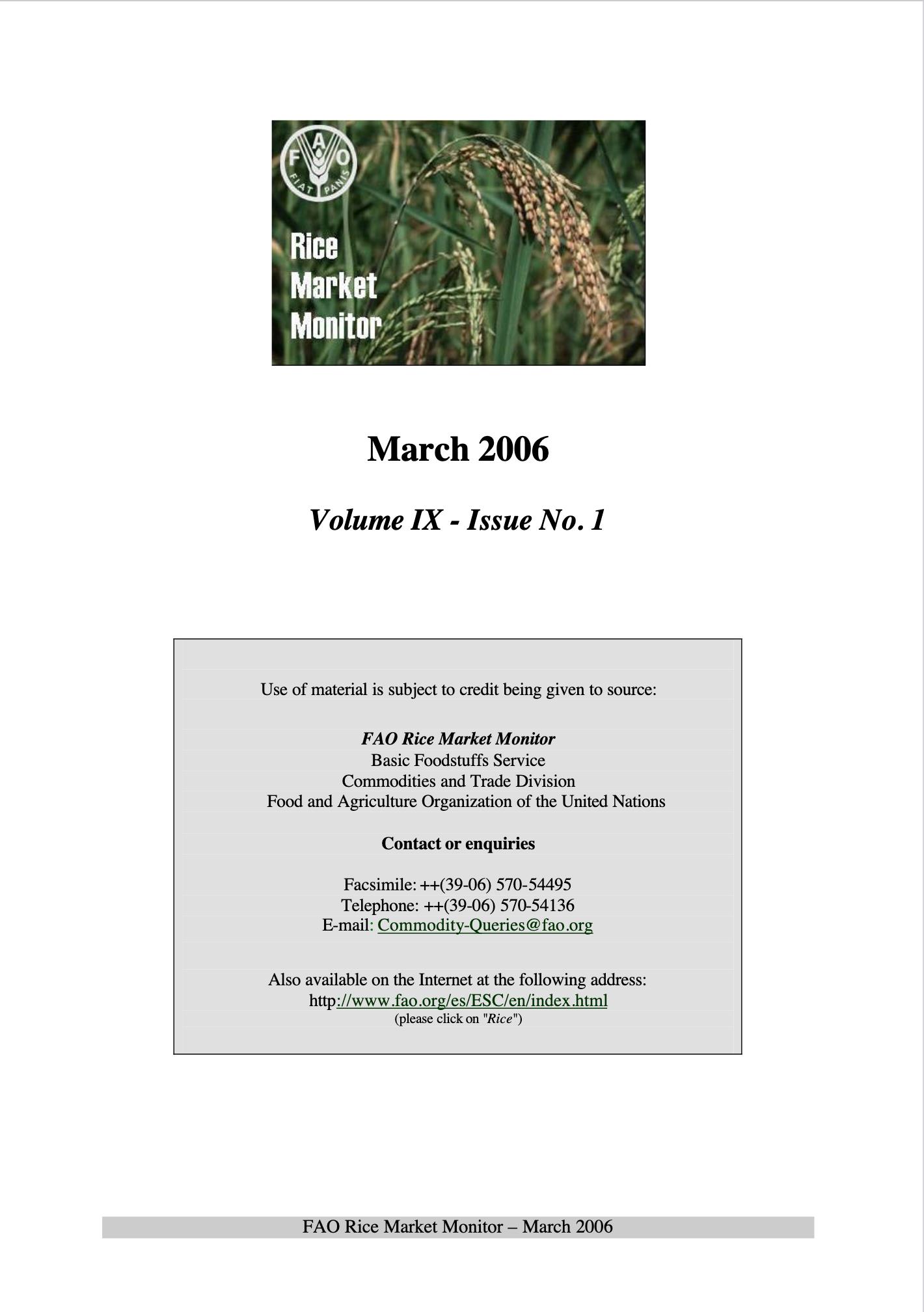
Rice Market Monitor - March 2006
11/09/2006
2005 was a record breaking year for the world rice economy. For the third consecutive season, global paddy production experienced a brisk expansion, which lifted it to an all time high of 628 million tonnes. Growth reflected relatively favourable weather conditions in Asia, western Africa and South America and the positive effects of high prices in 2004, which had fostered a general increase in plantings. Tight domestic supplies in a number of countries confronted with production shortfalls in 2004 prompted a surge of global imports in calendar 2005 to a record volume of 29.0 million tonnes. The expansion in trade in 2005 took place despite relatively tight export availabilities in Thailand and China (mainland), as reduced sales from these countries were more than compensated by increased shipments from the other major exporting countries, in particular India, Pakistan and Viet Nam.
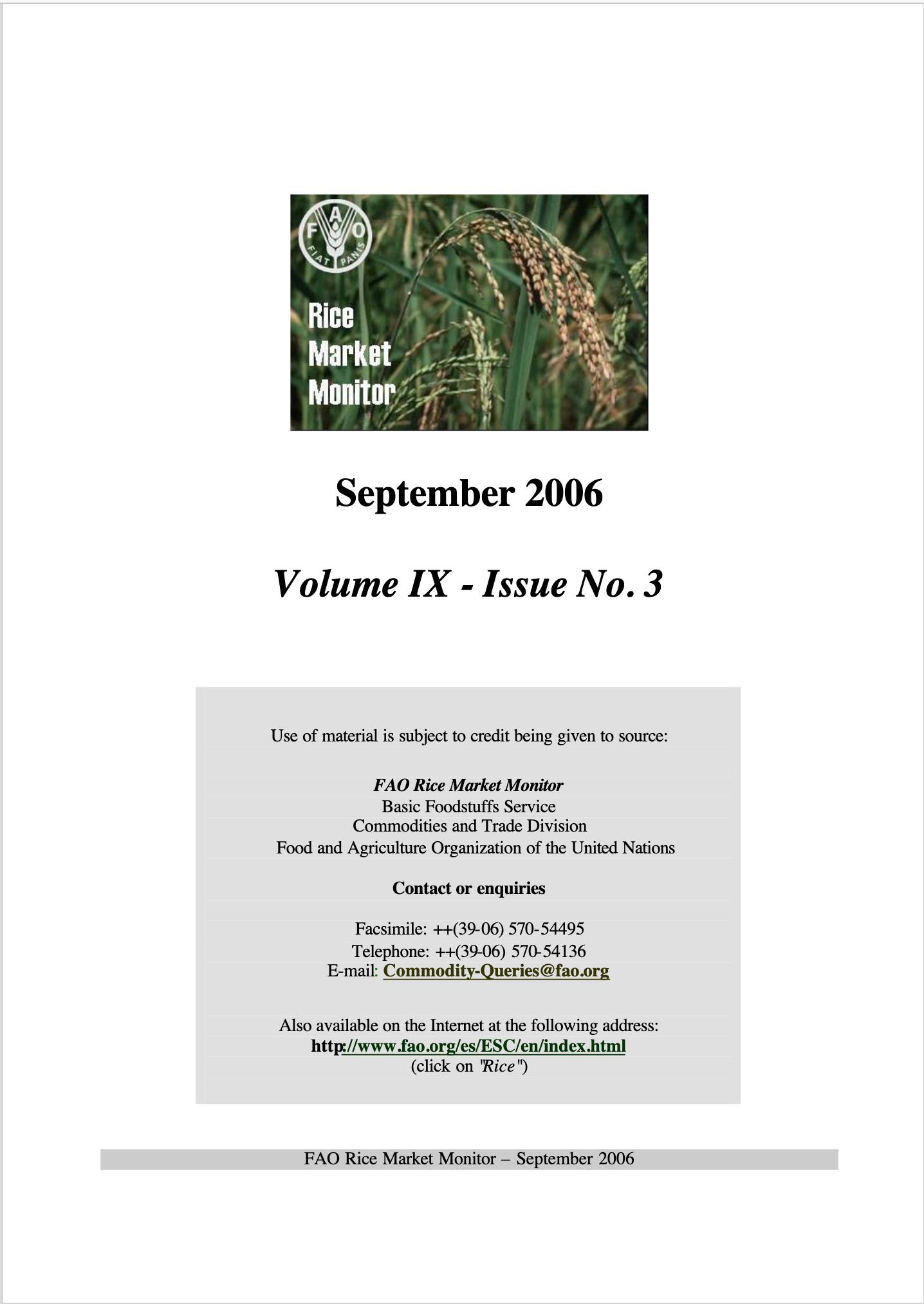
Rice Market Monitor - September 2006
11/09/2006
FAOs forecast for global paddy production in 2006 has been downgraded by 2 million tonnes from last report and now stands at 635 million tonnes, marginally above the 2005s level. Much of the downward revision reflects adverse weather conditions, which have led to much less buoyant crop prospects in Bangladesh, China and Nepal.
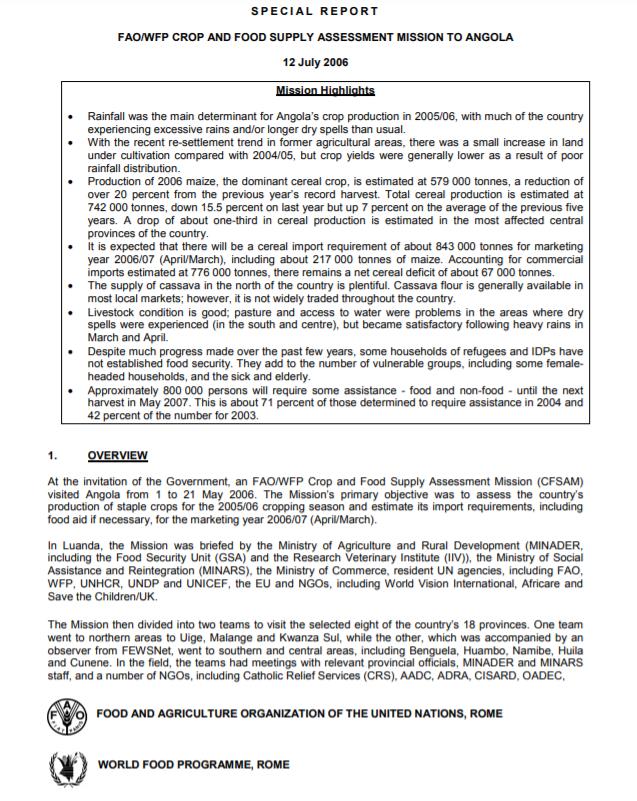
Special Report - FAO/WFP Crop and Food Supply Assessment Mission to Angola - 12 July 2006
12/07/2006
At the invitation of the Government, an FAO/WFP Crop and Food Supply Assessment Mission (CFSAM) visited Angola from 1 to 21 May 2006. The Mission’s primary objective was to assess the country’s production of staple crops for the 2005/06 cropping season and estimate its import requirements, including food aid if necessary, for the marketing year 2006/07 (April/March).
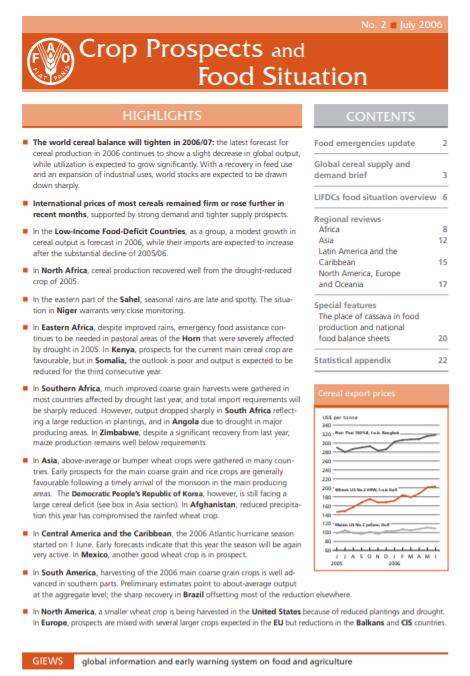
Crop Prospects and Food Situation #2, July 2006
06/07/2006
The world cereal balance will tighten in 2006/07: the latest forecast for cereal production in 2006 continues to show a slight decrease in global output, while utilization is expected to grow significantly. With a recovery in feed use and an expansion of industrial uses, world stocks are expected to be drawn down sharply. International prices of most cereals remained firm or rose further in recent months, supported by strong demand and tighter supply prospects. In the Low-Income Food-Deficit Countries, as a group, a modest growth in cereal output is forecast in 2006, while their imports are expected to increase after the substantial decline of 2005/06.
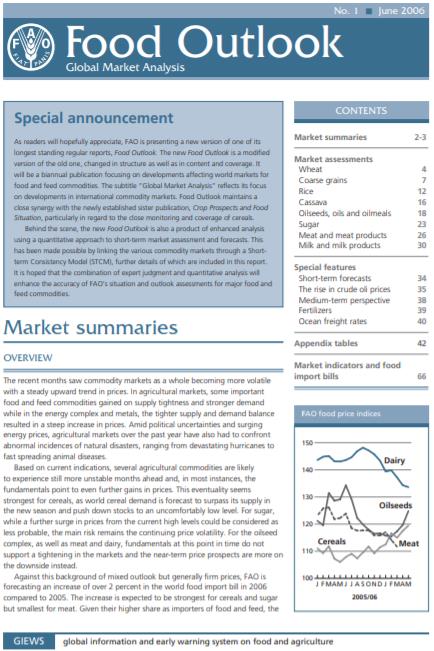
Food Outlook - June 2006
05/06/2006
The recent months saw commodity markets as a whole becoming more volatile with a steady upward trend in prices. In agricultural markets, some important food and feed commodities gained on supply tightness and stronger demand while in the energy complex and metals, the tighter supply and demand balance resulted in a steep increase in prices. Amid political uncertainties and surging energy prices, agricultural markets over the past year have also had to confront abnormal incidences of natural disasters, ranging from devastating hurricanes to fast spreading animal diseases.
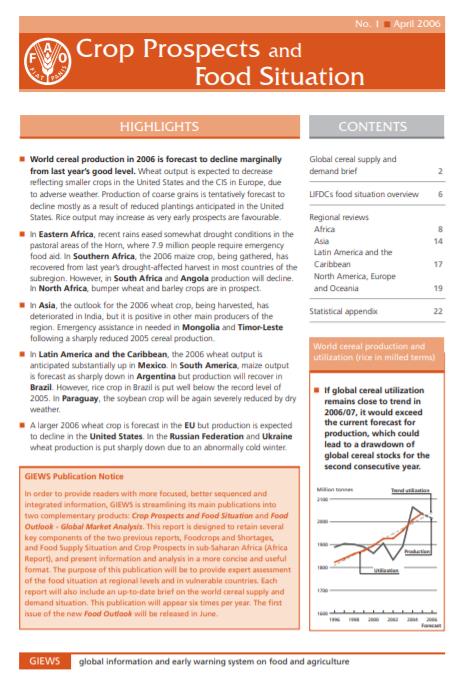
Crop Prospects and Food Situation #1, April 2006
06/04/2006
World cereal production in 2006 is forecast to decline marginally from last year’s good level. Wheat output is expected to decrease reflecting smaller crops in the United States and the CIS in Europe, due to adverse weather. Production of coarse grains is tentatively forecast to decline mostly as a result of reduced plantings anticipated in the United States. Rice output may increase as very early prospects are favourable.
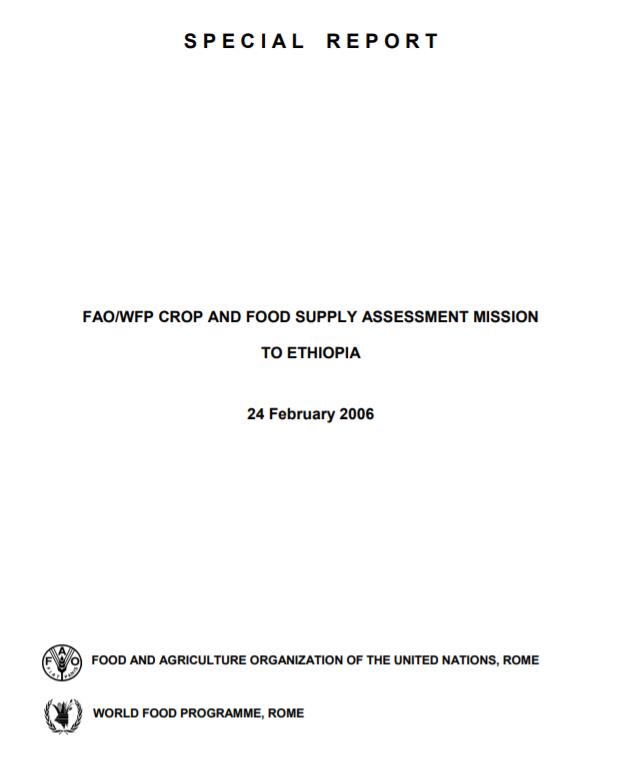
Special Report - FAO/WFP Crop and Food Supply Assessment Mission to Ethiopia - 24 February 2006
24/02/2006
An FAO/WFP Crop and Food Supply Assessment Mission visited Ethiopia from 12 November to 11 December 2005 to estimate the main meher season cereal and pulse production; review the final estimates of the 2004 meher and 2005 secondary belg season harvests; forecast the 2006 belg season production; assess the overall food supply situation; and estimate cereal import requirements, including food aid needs, for the 2006 marketing year (January/December). Accompanied by experts from the Federal Ministry of Agriculture and Rural Development (MoARD), the Central Statistics Authority (CSA) and an USAID observer, the Mission, in seven teams, visited sixty-two zones and special woredas (districts), over a 20-day period, in all the grain producing regions. Parallel to the crop assessment teams but spread over a longer period, 25 teams, led by the Government’s Disaster Prevention and Preparedness Authority (DPPA) and with members comprising WFP, bilateral donor agencies and NGO personnel, visited marginal localities and vulnerable zones and woredas to determine their current and prospective food security situation.
